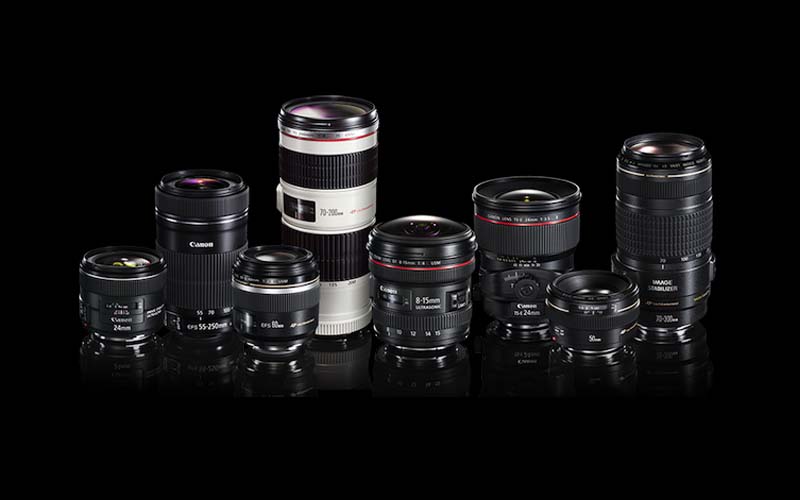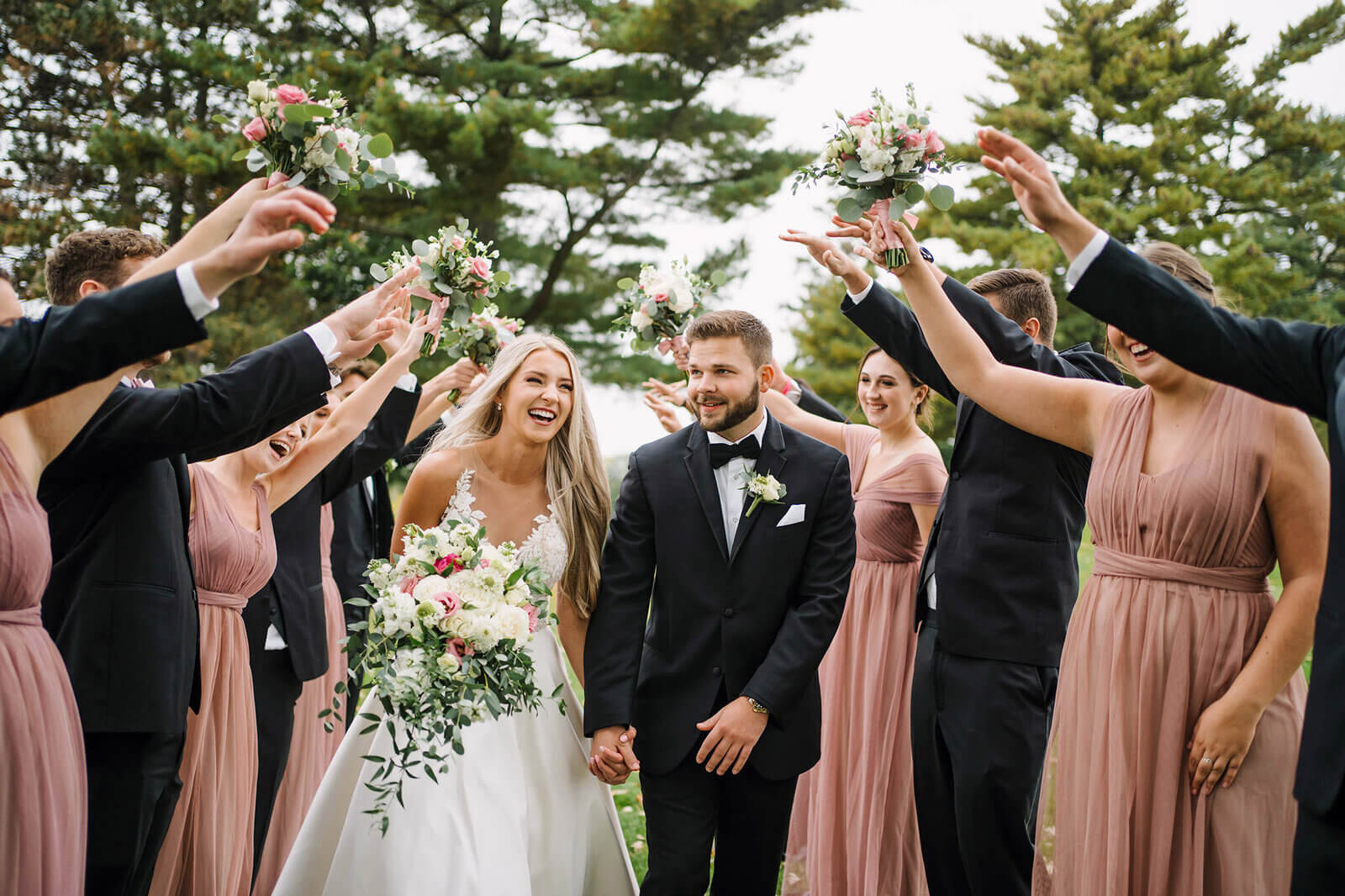Photographers’ obsession with camera lenses is nothing new, and it’s a good obsession. Because the camera lens and its different variants make it easy to capture the different beauties of the world.
And Canon lenses come on the top, most of the time, if not always. As we’re focusing on portraits, what is the best canon lens for portraits to you?
There are many lenses available in the market with different combinations of features. Troubled? Don’t be. After this, you’ll know what is what when it comes to Canon lenses.
We have our favorites for the position, and in this article, we’ve laid out their details and focused on their positives, negatives, and specialties.
Learn: How to clean camera lens
Our recommendation of the best canon camera lens for portraits photography in 2024
We have gathered here the 10 lens for portraits canon that we think are the best for portrait photographs. Each one differs from one another in terms of focal length, aperture, adjustability as well as price. Here’s a short comparison between them.
1. Canon EF 50mm – Best canon 50mm lens for portraits
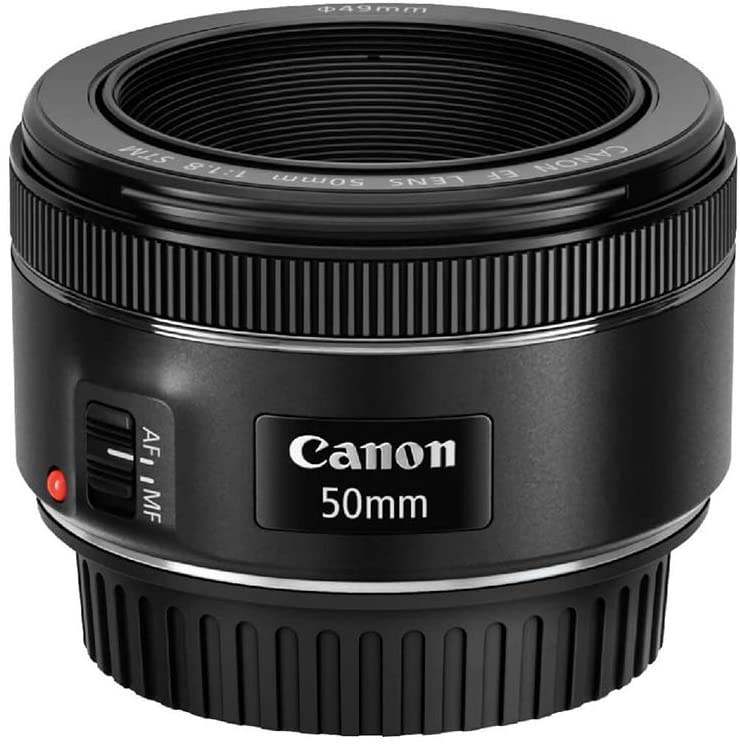
Starting with Canon’s most trusted lens, the nifty fifty, which has been the standard lens for Canon users for ages. It has all the basic features a photographer needs in day to day photography. But is it good for portraits?
This lens has ElectroFocus technology, also known as Automatic focus. A dedicated motor built into the lens controls the autofocus, and in this specific lens, it’s the Stepping Motor or STM. STM is known for its smooth and faster focusing. It’s better for taking photos and videos, but the latter is its specialty.
Moreover, STM is also great for taking videos in a quiet manner as opposed to USM, where it makes a bit of noise. Then again, this lens has slower autofocus than those lenses with USM.
Next, you see that this lens has a focal length of 50mm, which is just right if you want to take both landscape and portrait photos. To be fair, this isn’t the best focal length for taking portraits, but at its price, it’s worth it. You also get the option to take standard landscape photos.
That being said, the shortcoming of the focal length is greatly compensated by the lens’s aperture. At f/1.8, this is the ideal aperture for creating the bokeh effect. We all know how a smooth bokeh takes a portrait to another level.
With all its features considered, it’s suited to take portraits, action, and nighttime photography.
Pros
- Smooth autofocus
- Silent action
- Portraits, nighttime photography
- Ideal aperture for bokeh
- Prime lens gives better image quality
Cons
- Shorter focal length
2. Canon EF-S 24mm f/2.8 STM Lens – Best for travel and street photography
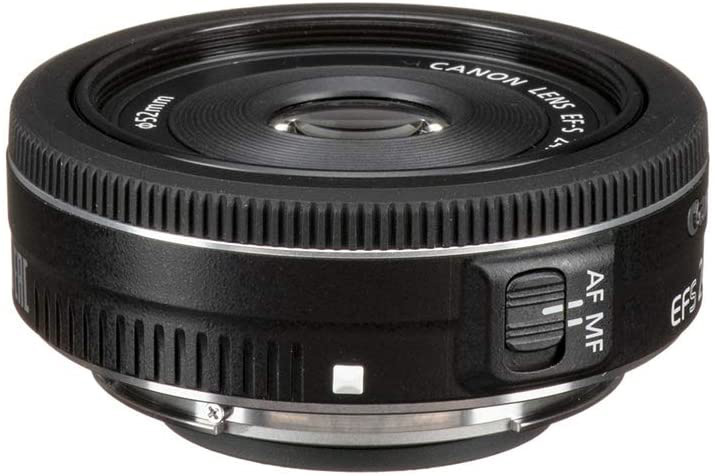
This Canon lens is also a member of Canon’s EOS and SLR family and built for APS-C cameras. The shape of this lens is different from what the standard lenses look like. Due to its shape, people call it the “Pancake lens.” And that’s where it gets the denotation “S” in its name.
Just like most Canon lenses, this one also incorporates the Stepping Motor to drive the autofocusing EF mechanism. STM allows smoother and faster focusing than direct drive motors. This feature is better at taking videos while maintaining great quality in taking photos also.
The focal length of this lens is very short, at just 24mm. It’s one of those wide-angle lenses that focus more on the background than the object. So, it’s not the optimum option for taking portraits, although, with the help of the aperture, it can manage.
With an aperture of f/2.8, it does help out the 24mm focal length to take portraits with an appreciable bokeh effect. The aperture size is the minimum to have that bokeh and blurred background. So, there’s some give and take with this lens’ combination.
It’s a prime lens dedicated to one type of photo, and that allows it to take better image details to produce crisper images. As far as image quality is concerned, there’s only one thorn to pick. And it’s the absence of image stabilization technology.
Pros
- Sharp image
- Compact
- Inexpensive
- Silent and smooth focusing
- Wide-angle
Cons
- No image stabilization
- Not an optimum choice for portraits
3. Canon EF-S 55-250mm f/4.0-5.6 IS II Telephoto Zoom Lens – Best for Portraits, Sports, Wildlife
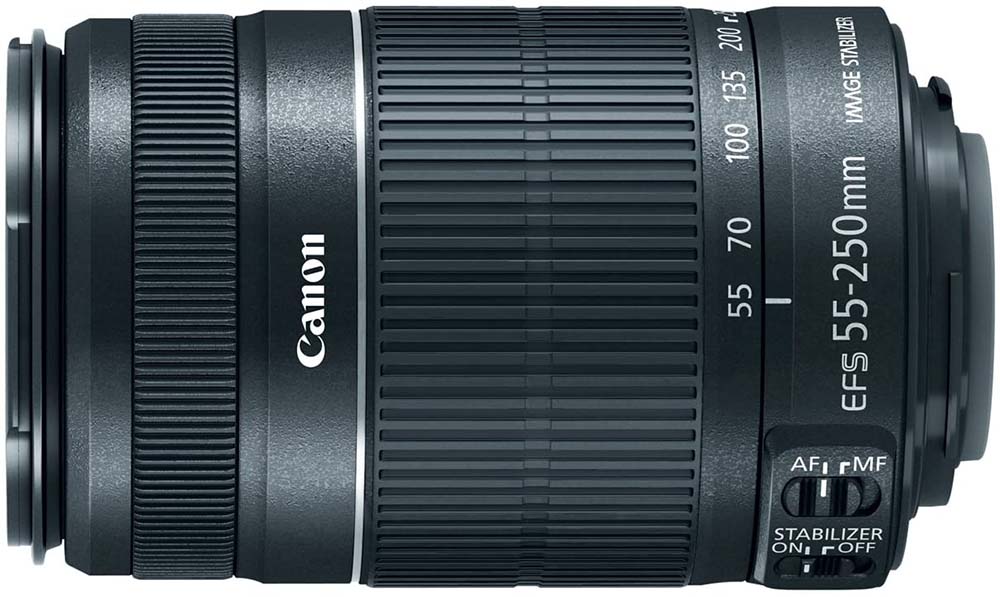
This is one of the best Canon lenses for portrait photography. If you’re looking for a lens that can take sharp and detailed portraits while being in the affordable range, then this Telephoto lens is for you. With a long focal length and adjustability combined, this gives a lot of room for experiments.
Talking about long focal length, it starts at 55mm and can go up to 200mm. So, taking landscape photos with high-quality portraits is its specialty. The higher you go, the more it focuses on the object of your focus, a vital point for portraits.
The aperture in this lens is also adjustable, just like the focal length. You can choose between f/4 and f/5.6 aperture when taking photos. This also means that it doesn’t create that much of a bokeh effect due to being narrow. And also, lowlight photography isn’t its forte.
It’s a compact telephoto lens, as you can see in its name. The EF-S denotation makes it only compatible with APS-C cameras. All in all, Canon focused on making it versatile and standard while keeping the price low. Don’t forget that it has image stabilization, which many lenses lack.
The motor in its lens is an old micromotor, which isn’t as fast as USM or as smooth as STM. But it manages to give the photographer a good photography experience. For an intermediate level photographer, this should be a great buy.
Pros
- Adjustable focal length and aperture
- Compact
- Affordable
- Great portraits
- Image stabilization
Cons
- Micrometer instead of STM or USM
- Lowlight photography isn’t great
4. Canon EF-S 10-18mm f/4.5-5.6 IS STM Lens – Best for Abstract Photography
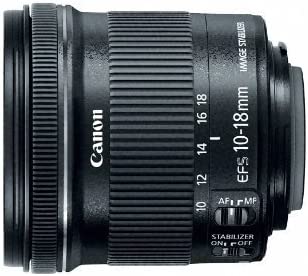
Canon has so many variants of lenses in store that you can get lost in them. And among them is this ultra-wide-angle lens that is also compact. It also has a great depth of field to get the sharpest details of the objects in your photos. How about portraits?
The ElectroFocus, a.k.a autofocus on this lens, is controlled by an STM focus motor. It’s a whole lot better than old motors and better at smooth focusing than ultra-sonic motors.
The focal length on this lens is one of the shortest among Canon lenses. With an adjustable range of 10-18mm focal length, it provides great wide-angle photography options.
While it takes great landscape photos, it loses prowess in terms of close shots and portraits. But you can take great portraits in the right settings.
In terms of aperture, it has a very narrow aperture ranging from f/4.5 to f/5.6. The basic knowledge of aperture will tell you that this lens is geared to take sharp images with its great depth of field capturing the tiniest details.
This lens also incorporates Canon’s image stabilization technology, giving you the ability to take beautiful photos on the move. Not many canon lenses have this ability, and you’re getting it in such an inexpensive lens.
All that being said, it’s not recommended for only portrait photography. Another point to note is that it’s only compatible with an APS-C camera with EF-S mountings.
Pros
- Great depth of field
- Ultra-wide
- Image stabilization
- STM for smooth focusing
- Compact and affordable
Cons
- Short focal length isn’t for portraits
- Only compatible with EF-S mounting
5. Canon EF 85mm f/1.8 USM Camera Lens – Best For Portraits, Low-Light Shots
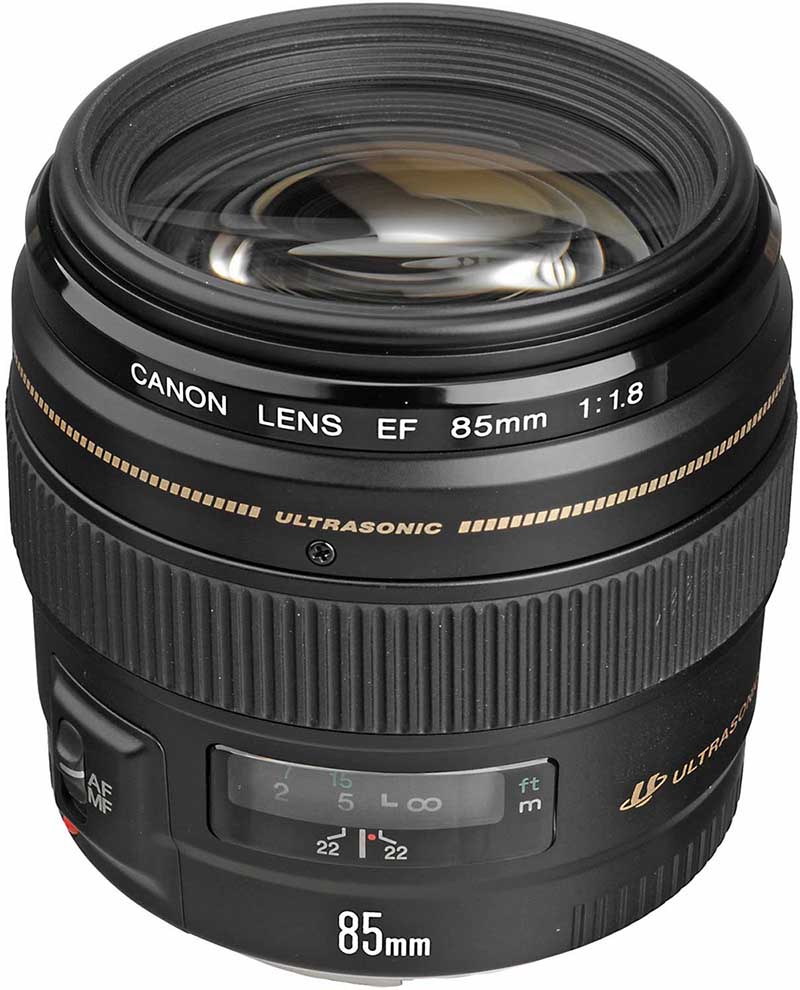
At number 5, we have a prime Canon lens, which is dubbed as the best canon lens for family portraits or portraits in general. A prime lens means it has a fixed focal length and aperture. This dedicated setting is better at taking high-quality images than adjustable settings.
This lens is for the full-size canon cameras and has an Ultra-sonic motor for focusing on objects. The autofocus in this type of lens is the fastest among all lenses thanks to this motor, although it’s not as smooth or quiet as Stepping Motors.
According to expert photographers that have spent years in the field, the focal length on this lens is the starting point for taking great portraits. With an 85mm focal length, it provides the right amount of focus on the object taking crisp photos. And when it’s coupled with a great aperture, it’s the best at this price.
Talking about great aperture, this lens has an f/1.8 aperture, which is exceptional for two things: creating a bokeh effect and lowlight photography. Want to take nighttime photos and portraits with smooth bokeh? This is the lens to get.
If we’re talking portraits, there is no single negative about this lens. Except, we all can do more with longer focal lengths! Want is never-ending! That said, it’s a bit pricey than standard lenses but nothing to make you back off from buying it.
Pros
- Excellent portraits
- Ideal aperture for bokeh effect
- USM provides fast autofocus
- Affordable
- Lowlight photography
Cons
- Doesn’t come with a hood
6. Canon Cameras US 6310B002 EF 40mm f/2.8 STM Lens – Best For Street, Travel, Portraits
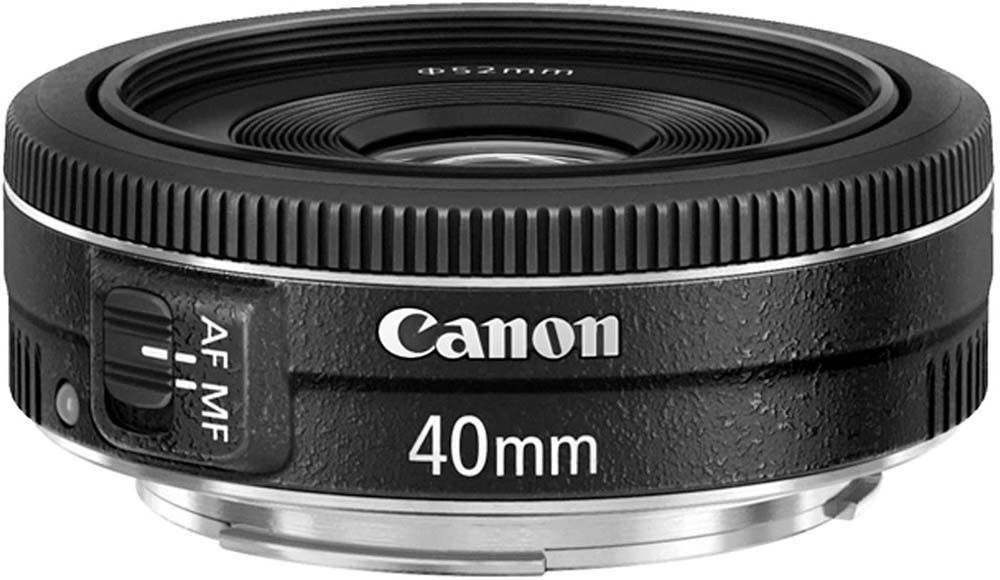
This EF lens first came out in June 2012. It was one of the first two lenses using Stepping Motor as its autofocus driver. Being one of the more inexpensive lenses, the compact size gained popularity among amateur photographers as well as professionals.
The Stepping Motor first gained its STM designation with this lens. Since then, it has been known as their quiet lens suited to wildlife photography. It’s not only quiet but also provides smooth autofocus – making it a suitable choice for movie making.
Regarding the lens’ focal length of 40mm, it may seem odd seeing both 35mm and 50mm existing already. But this was a clever move by Canon as it can be used in the 35mm SLRs. Secondly, many photographers think of it as the perfect normal lens that provides the image’s natural perspective.
When taking portraits, photographers prefer a longer focal length. Despite having a 40mm focal length, this one can provide good portraits, thanks to its wider aperture of f/2.8. It lets in just the right amount of light and maintains a bokeh effect. But you may see a slight vignette effect.
Being a prime lens, it delivers higher quality images than the zoom lenses. Of course, you miss out on the adjustability, but that’s life. Gain some, lose some.
Pros
- Affordable
- High-quality images
- Quiet and smooth autofocus
- Aperture gives bokeh effect
- Delivers a natural Image
Cons
- Longer focal length performs better at portraits
- Vignette appears at this aperture
7. Canon EF 100mm f/2.8L IS USM Macro Lens – Best For Portraits
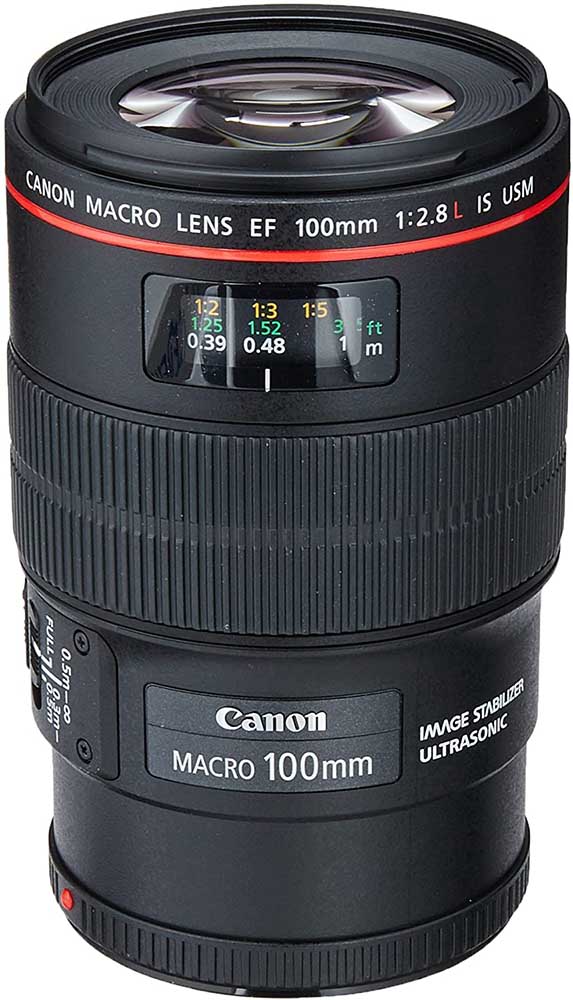
Is there a perfect prime lens for taking portraits? There can be many, and this Canon lens is among them. This is Canons’s first Macro ‘L’ series lens to come out, and it has come out strong. It has a fine combination of focal length and aperture as well as other technologies. Let’s get to know this beauty a bit more.
To start off, this lens has the fastest autofocus, thanks to the latest ultra-sonic motor from Canon. It’s faster than Stepping Motors and smooth enough. Fortunately, this lens has the optical image stabilization feature craved by all photographers.
And then we have a long focal length of 100mm, and that’s just perfect for portrait photography. It’s a mid-range telephoto prime lens. They say the sweet spot for portraits is between 75 and 300. With the image stabilization technology, you shouldn’t worry about taking crisp portraits.
It doesn’t end there as the lens has an aperture of f/2.8, which is termed as the minimum for achieving that bokeh and blurred background. And it also allows a good amount of light to enter for low lighting conditions.
Yes, it’s expensive, but if you’re looking for something that’s wrong with this lens, you’ll be disappointed. This is a versatile lens that is capable of providing a great depth of field, bokeh, and handheld movie-making. And all this justifies the expensive price point.
Pros
- Perfect focal length
- Ideal aperture
- Image stabilization
- USM for fast autofocus
- Lightweight
Cons
- Expensive
8. Canon EF-S 24mm 1.2.8 STM – Best For Landscape
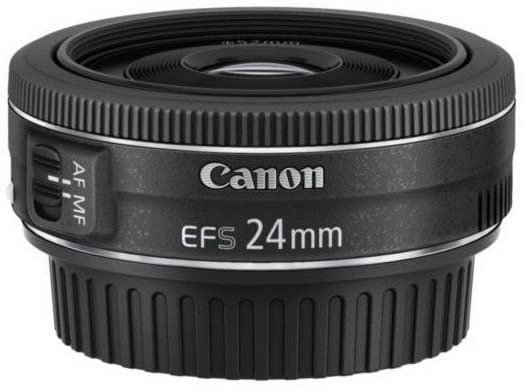
Canon’s EF-S series lenses are known for their compact size with a pancake shape. This canon lens delivers sharp, detailed, and bright images at a much affordable price point. But it might not attract portrait-only photographers because it’s a wide-angle lens. There are some other reasons for that.
Before going into the details, know this formula; Shorter focal length makes the camera focus on the background, and longer focal length focuses more on the object. So, looking at this lens’ 24mm, it’s understandable that it won’t perform the same as a 55mm lens in portrait photography.
But just like some other lenses, it is somewhat compensated by an f/2.8 aperture. With an aperture of this width, you can get a blurred background with a vignette/bokeh effect.
And this, my friend, will give you that portrait shot you’re looking for. It also gives you the option to take photos in slightly low lighting conditions.
The autofocus on this lens is driven by a Stepping Motor. This lens is great for wildlife photography as the STM is so quiet that animals won’t know what’s happening even with their highly sensitive ears.
When you’re working with one-shot autofocus mode, you can also manually focus on the object. It gives you the ability to be more in control of your shots rather than relying on the lens. And the fact that it’s cheap makes it a great option.
Pros
- Wide-angle lens
- Aperture is good for bokeh
- Lowlight photos
- Quiet and smooth autofocus
- Manual focus in automode
- Cheap
Cons
- Not long enough focal length for perfect portraits
9. Canon EF 75-300mm f/4-5.6 III Telephoto Zoom Lens – Best For Portrait, Close Up Shots
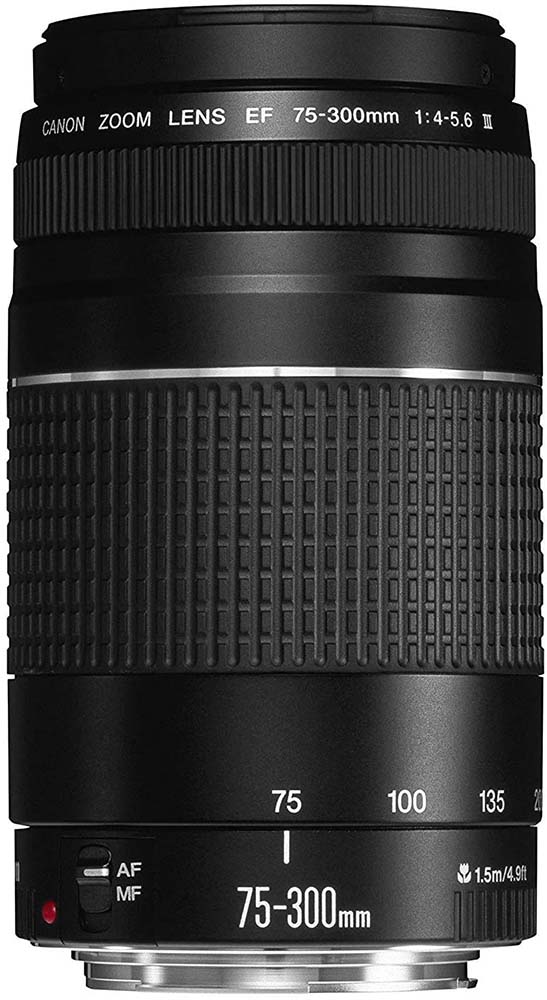
If you’re not satisfied with ordinary zoom lenses, you may want to take a look at the giants of zoom lenses, the telephoto lenses. Here, we have the newer telephoto lens from Canon.
It’s the more updated cousin of the 3rd lens on this list. Having a similar build and design, it has more capability at taking portraits and a better motor for autofocus. Another difference is in camera compatibility, as this lens is for EF mounts.
These lenses have the longest focal length ranges. This one starts from 75mm and ends at 300mm. Even professionals stay satisfied with it when it comes to taking portraits.
The adjustable aperture on this zoom lens has a range of f/4-5.6. That should tell you that it doesn’t care much about bokeh, rather focuses on the depth of field.
If you don’t want a sharp and not-blurred background in your images, this is a great option. But due to the narrow aperture, this lens falls short when the lighting condition isn’t good.
In terms of autofocus, this incorporates Canon’s ElectroFocus with a Micro-type Ultra-sonic motor or USM. This type of motor delivers the fastest smooth focusing. But note that it isn’t as quiet as STM motors. Wildlife photography needs quiet action.
Having such great features, you might say it’s the best canon zoom lens for portraits. Despite that, it’s very much affordable, making it an ideal choice for people wanting to start photography.
Pros
- Zoom lens
- Great depth of field
- Micro-type USM
- Long focal length
- Affordable
Cons
- Poor lowlight capability
- Doesn’t create a good bokeh
10. Canon EF 50mm f/1.4 USM Camera Lens – Best For Portraits
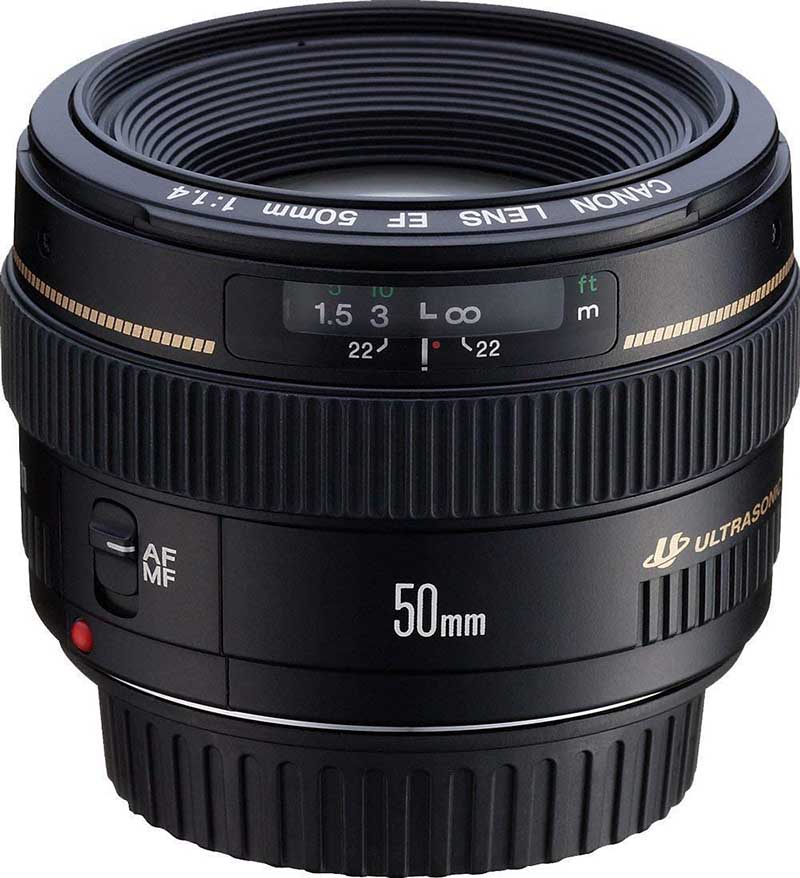
The EF 50mm f/1.4 USM is a mid-level offering from Canon, among many other 50mm lenses. It’s the most updated version of 1971’s manual focus 50mm, f/1.4 lens. It doesn’t break your bank while providing you with enough features and opportunities for great photography.
For starters, the autofocus on this lens is controlled through an ultra-sonic motor. This is a micro-type USM (not the ring USM), and it is fast and smooth. You can also manually focus the lens whenever you want, even in autofocus mode.
This EF lens has the nifty fifty 50mm focal length, which is not too short for portraits and not too long for landscape photography. Although it’s not a standard telephoto lens for portraits, it behaves like one. And no distortion is to be noticed before and after taking photos.
The aperture on this lens is the widest of the bunch on this list. With an f/1.4 aperture, it lets the most light in delivering bright, detailed photos in low lighting conditions.
It’s also an ideal aperture for creating a soft, smooth bokeh on your portraits. You can see how the combination of 50mm and f/1.4 makes it a great tool for portraits.
Another reason why it’s so popular among users is its compact and light build. Despite being one of the older Canon lenses, it still holds a place in day to day photography.
Pros
- Great aperture for bokeh effect
- Provides good portraits
- Fastest autofocus
- Inexpensive
- Lowlight photography
Cons
- USM isn’t quiet
- No zooming
Different Types of Camera Lenses and When to Use Them
When it comes to camera lenses, there are many different types of them in each category. And each one of them has its own areas of specialty. Here, we’ll go through them very briefly before going into our buying guide.
Prime Lens
This is the classic style of lens existing from when the cameras were invented. The main property of a prime lens is its fixed focal length, meaning there’s no zooming in or out.
Their job is to focus on one type of photography, and having a fixed focal length makes it cheaper than zoom lenses. And it also produces better images. So, if your photography isn’t versatile, this is the lens you want to use.
It can take portraits, landscapes, and all sorts of shots if the focal length is right.
Zoom Lens
A zoom lens is the opposite of a prime lens. It’s all about versatility. The need for a zoom lens arose when photographers needed to do different types of photography in a single session.
With a zoom lens, you can go from landscape photography to portraits. But it does produce images with less quality compared to prime lenses. The most common in them is the 50-200mm focal length.
Telephoto Zoom Lens
If you’re not satisfied with a normal zoom lens, you can go towards the telephoto lenses. Their focal length starts around 85mm and can go up to 600mm or more. Although for most people, 600mm is more than enough.
They’re bigger in size and hard to control. If you’re someone who fancies wildlife, sports, night sky photography, then you should look at a telephoto zoom lens.
Wide-Angle Lens
These lenses are for one thing only, and it’s taking wide shots. They have the lowest focal lengths among all, which helps to focus more on the background than the object. They are perfect for landscape photography.
The focal lenses start from as low as 8mm and can go up to 35mm, but 24mm is a good limit to have. Those with focal length under 18mm are also known as fish-eye lenses or ultra-wide lenses.
What to Look for Before Buying?
When you’re on the market for a camera lens focusing on portrait photography, there should be some criteria to find the best canon lenses for portrait photography. In different scenarios, you’ll need different features to take the best photos possible. Let’s talk about them.
Focal Length
You’ll find a lot of lenses with the difference in focal length. Starting from as low as 8mm, it can go up to 600mm. But not all of them are good for portraits, especially those with small focal length.
If we were to put a certain limit on the minimum focal length, then it’d be the lenses with 50mm, and they’re also known as nifty fifty lenses. But the sweet spot starts from 85mm and up. Of course, the price also increases with focal length.
For most photographers, professionals, and amateurs, a good range would be 55-300mm.
Get a zoom lens and be done with it!
Aperture
The aperture of a lens plays a vital part in the production of an image. It determines the amount of light entering the photo chamber. The bigger the aperture, the more light it lets in.
A narrower aperture is good for those situations where there is a lot of light. And wider apertures are good for low light photography because here you need as much amount of light as possible to enter.
Another effect of the aperture is the bokeh effect you want in portraits. Larger apertures such as f/1.4, f/1.8 are better, but f/2.8 is the minimum if you work with an 85mm lens.
A good combination of focal length and aperture size is needed to get good portraits. A good combination can be 55-300mm and f/2.8.
Image Stabilization
Make sure that your lens has some sort of image stabilization technology. If your camera has digital image stabilization, then that can compensate for the lack of image stabilization in your lens.
Types of Motor in Lens
There are three types of motors used in lenses. Most Canon lenses will have either Ultrasonic Motor (USM) or Stepping Motor (STM). Although the two have no significant effect on the image quality, you might want to prefer one over the other.
The USM is the fastest focus motor among Canon lenses, where the STM is known for its smooth and quiet focusing. So, the STM works better when taking videos.
When these two motors aren’t present, then it means that the lens is using a Direct Drive motor or conventional DC motor. It does have autofocus but not as fast as USM or as smooth as STM.
FAQ’s
Q: What is a Canon EF lens?
Ans: The EF lens is the most common lens used with Canon SLR and digital cameras. It’s the standard lens of the Canon EOS family. EF means Electro-Focus. It’s an automatic focusing mechanism controlled through a dedicated motor.
Q: What mm lens is best for portraits?
Ans: If you’re looking for a lens to capture more of the object than the background, then your best choice is to get an 85mm lens. Although a 50mm lens provides better portraits than 24mm lenses, it still captures much of the background. The 70-200mm lens has been dubbed as the sweet spot.
Q: What lens to use for portraits?
Ans: The key to getting the best portraits is a longer focal length and a larger aperture. Go with an 85mm lens or longer for portraits and an f/2.8 aperture for a better bokeh effect.
Q: What Canon lens should you use for portraits?
Ans: Among the Canon lenses, the EF 85mm lens is the standard that takes good portraits. But the most recognized lens is the Canon EF 70-200mm, f/2.8 lens.
Q: Which is a better lens for the Canon T5, the 50mm or 35mm for portraits?
Ans: For portraits, the better option is always the lens with a longer focal length. Here, it’d be the 55mm lens. Get a lens with adjustable focal length; it’s always the best option.
Q: What Canon lens should I buy?
Ans: Always go for Canon prime lenses. And among them, the best would be the Canon Telephoto 70-300mm, f/4-5.6 lens for portraits. Canon EF-S 55-250mm lens is another great option.
Q: What makes portraits sharp?
Ans: If you want sharp portraits, then a lens with a lower aperture is better. But too low aperture will also reduce the bokeh effect you want in your portrait shots.
Final Words
That’s it! Our job is finished. Now, it’s up to you to pick the best Canon lens for portraits. The zoom lenses are our favorite. It’s clear from the reviews that some lenses just perform better than others.
